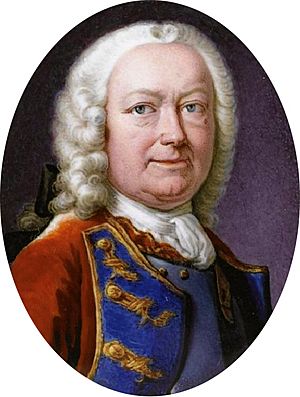William Hargrave facts for kids
Quick facts for kids
William Hargrave
|
|
|---|---|

William Hargrave
|
|
| Died | 21 January 1751 |
| Allegiance | |
| Service/ |
British Army |
| Rank | Lieutenant general |
| Battles/wars | Nine Years' War War of the Spanish Succession Jacobite rising of 1715 |
William Hargrave was an important officer in the British Army. He became a Lieutenant General, which is a very high rank. He was also the Governor of Gibraltar, a key British territory. William Hargrave passed away on January 21, 1751.
Contents
William Hargrave's Military Journey
William Hargrave started his army career in 1694. He became an officer in a group called Viscount Charlemonte's Regiment of Foot. This meant he was given a special role to lead soldiers.
Early Battles and Wars
From 1694 to 1696, Hargrave fought with his regiment in the Low Countries. These areas are now parts of Belgium and the Netherlands.
Later, in 1702, he took part in the War of the Spanish Succession. This was a big war that involved many European countries. During this war, he fought in several important battles:
- The Battle of Cádiz
- The Battle of Vigo Bay
- The Siege of Barcelona in 1705
- The Battle of Almansa in 1707
Fighting in the Jacobite Rising
In 1715, William Hargrave was also involved in the Jacobite rising. This was a conflict within Great Britain. He fought at the Battle of Sheriffmuir, which was a major clash during this time.
Becoming a Colonel
In 1730, Hargrave was promoted to colonel. He was put in charge of the 31st Regiment of Foot. That same year, he was sent to Portsmouth. From there, he sailed with more soldiers to Jersey. This was to help stop a riot that the local leader could not control.
Leading the Royal Fusiliers
In 1739, he became the Colonel of The Royal Fusiliers. This was another important regiment in the British Army.
Governor of Gibraltar
Soon after, in 1740, William Hargrave was given a very important job. He became the Governor of Gibraltar. Gibraltar is a small but very strategic piece of land. It is located at the entrance to the Mediterranean Sea. As Governor, he was responsible for its defense and administration.
William Hargrave died in 1751. He was buried in Westminster Abbey, a famous church in London. His monument there was created by a well-known artist named Roubiliac.

